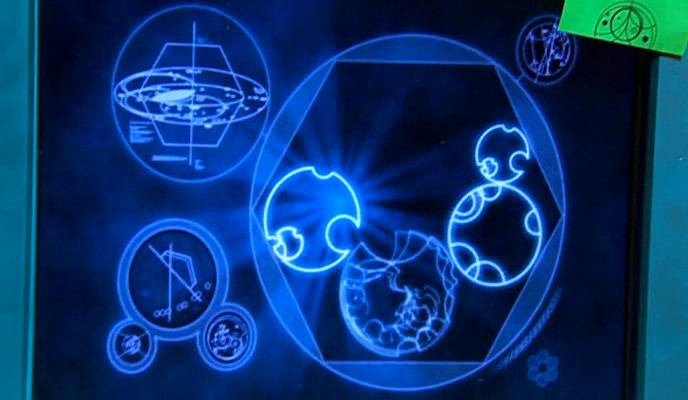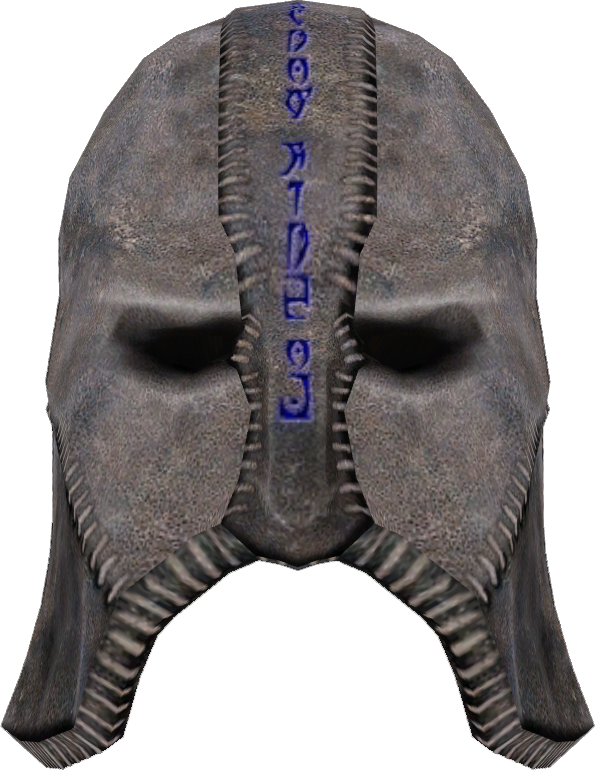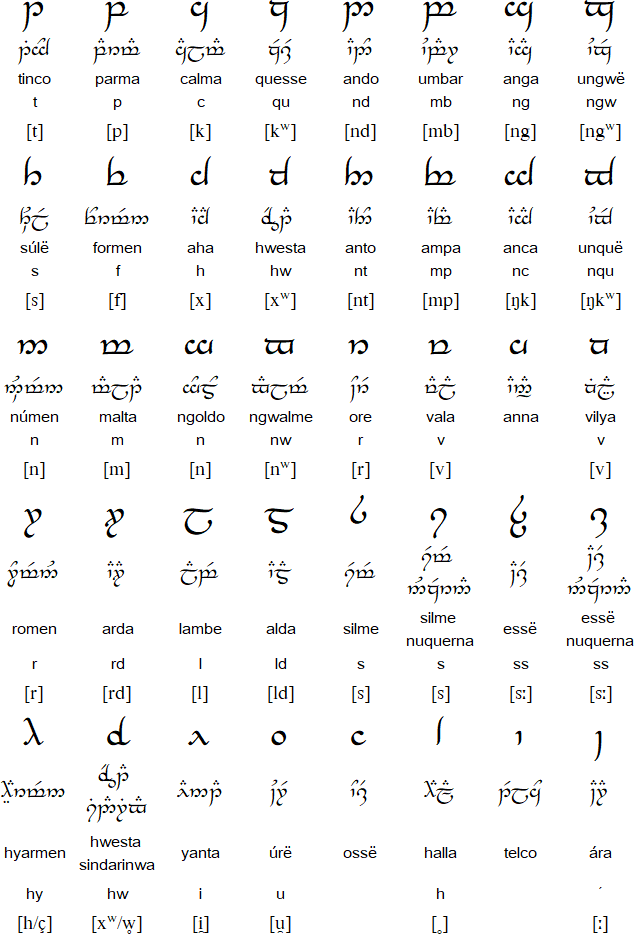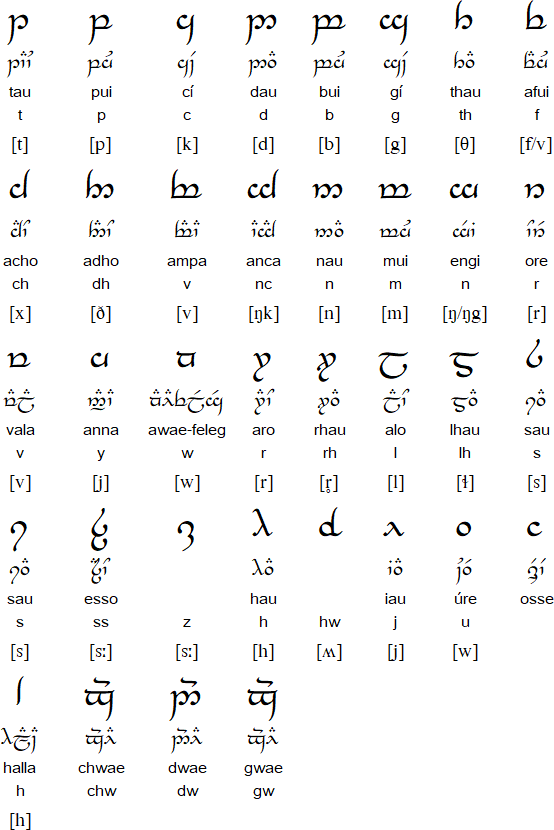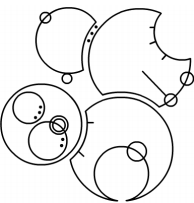Introduction
Authors of fiction, especially those of the science fiction
and fantasy genres, create immense worlds within their stories. They use a wide
assortment of tools to build rich histories, deep cultures, and lore that
extends far beyond the written words of their texts. One such tool that these
authors frequently employ is the creation of fictional languages. Whether by
modifying existing, real-world languages or by creating their own systems from
scratch, designing a language allows an author to craft a deep font of mythos and
culture from which readers can draw to their hearts’ content. Here I will be analyzing
several devices employed by the creators of three such languages: J.R.R.
Tolkien’s Tengwar Elvish, Doctor Who’s
Circular Gallifreyan, and The Elder Scrolls’
Daedric. Finally, I will provide recommendations for authors attempting
to craft a language of their own.
Please note that I will not be analyzing the translations of
these languages, only the physical appearance and rules for writing the script.
A Brief History
Before
delving too far into analyzing each of these languages, I wish to provide some
background information and context for them. Oftentimes knowing how a script
originated and how it is used can be key in determining its efficacy as a language.
J.R.R. Tolkien's Tengwar Elvish
Tengwar’s
first published appearance was in 1937 in Tolkien’s The Lonely Mountain Jar Inscription. Several of Tolkien’s other
scripts from the 1910s and 20s, such as Sarati and Valmaric, anticipated
features of Tengwar, indicating that the language had precursors and is the
result of several stages of evolution before the final version appeared in The Lord of the Rings in 1955. Most
prominently, the One Ring of Sauron bears an inscription in the Black Speech of
Mordor. Tengwar has several modes, representing different dialects of Elvish.
Here I will focus on two of these modes: the Quenya, or High-Elven, and the
Sindarin, or Gray Elven.
 |
| One Ring to rule them all, One Ring to find them, One Ring to bring them all, and in the darkness bind them |
Doctor Who's Circular Gallifreyan
The BBC
television serial Doctor Who
documents the adventures of a time traveler known only as The Doctor, the last
living Time Lord of Gallifrey and sole survivor of the Last Great Time War. The
Time Lords were, as the name implies, the custodians of the flow of time. Their
language is as nonlinear as the nature of time, and consists of nested and
interlocking circles. The screenshot below depicts a message on the console of the Doctor’s TARDIS. While the actual
translations of the language are not known, over the last decade or so the
show’s immense fanbase has compiled the available information about Circular
Gallifreyan to make an unofficial, yet widely accepted, system for
transliterating English.
The Elder Scrolls' Daedric Alphabet
The Daedric alphabet first
appeared in the 1997 video game An Elder
Scrolls Legend: Battlespire, where it was used to write English words. In
the game, the celestial academy of Battlespire was overrun by Daedra, a
capricious class of divine beings. The script next appeared in the 2002 game The Elder Scrolls III: Morrowind, where
it was no longer exclusively used by the Daedra, but also by the Dark Elves of
the titular Morrowind region. Further Elder
Scrolls games continue to use the Daedric script, and in all instances it
has been strongly affiliated with magicka. Items engraved with Daedric sigils
confer effects onto the player, such as the ‘Gray Cowl of Nocturnal,’ whose
inscription reads ‘Shadow Hide (Y)ou’. Predictably, the wearer gets a large
Stealth bonus, as shadows are the domain of the Daedric Prince Nocturnal.
Criteria for Analysis
The
primary criteria I will be using to analyze these scripts will consist of:
usage of diacritical marks, complexity of characters, and overall conveyance.
Firstly, diacritical marks exist in a great number of real-world language
systems, and are used extensively to alter the reading of a character or group
of characters. The simplest Latinate diacritics include the accents acute
(á), grave (à), and circumflex (â)
accents, as well as diaeresis (ä), breve (ă), and macron (ā),each of which
slightly changes the pronunciation of the letter. For fictional language
systems, diacritical marks can lend a great deal of complexity and depth, and
yet provide a way to make reading easier by allowing for explicit pronunciation
guides.
Secondly, complexity of characters can be a good indicator
of how accessible a language is. For example, the Chinese character for a type
of noodle called Biángbiáng consists of 58 individual
strokes and is one of the most complex characters in contemporary usage. This
is an extreme example in a real-world language, yet it shows there are
reasonable limits we must place in order to make a script easily to read and
write. Another facet of character complexity is similarity of glyphs. If
multiple glyphs have a similar root shape, such as our letters ‘d’, ‘p’, ‘b’,
and ‘q’, which are simply inversions of each other, then a reader may find a
script easier to learn and write, as there are fewer distinct glyphs to use. On
the other hand, it is possible that similar glyphs will be confused, so a bit
of discretion is required in saying whether or not similarity is good for a
given script.
Lastly, any language system must make its words
understandable; otherwise it serves very little purpose. Conveyance is the
manner in which a script delivers its meaning. Conveyance can include anything
from direction of writing, shape of the characters, and even the general ‘feel’
of a script. For instance, the Korean Hangul alphabet was created by Sejong the
Great in 1444 for the purpose of making the Korean language accessible to
everyone, not just the aristocracy who could read the Chinese hanja that were
used beforehand. As a result, the script is incredibly accessible, and has been
described as “the most perfect phonetic system devised” because the shape of
consonants denote the general shape of the reader’s mouth when pronouncing
them, and vowels are vertical or horizontal lines to easily distinguish them
from consonants. The Hangul alphabet has superb conveyance because it was
specifically designed to make the language easy for people of any standing to
understand. In my research, I will critique the fictional scripts on the basis
of how accessible they are for someone with no prior experience with the
language.
Analysis: Tengwar Elvish
In the Tengwar alphabet, vowels are indicated by diacritics
called tehtar, which appear above or
below their paired consonant. In the Quenya mode, vowels pair with the
consonants which precede them; in the Sindarin mode, vowels pair with the
consonants which follow them. When a vowel starts/ends a word or otherwise
stands alone, a special vowel holder character is used. This character is a
short or long vertical line, depending on which vowel appears. Long vowels
never pair; instead they always use a long holder.
The use of diacritical vowels in Tengwar allows for a single
character to cover a wide range of intonations with only minor changes.
Furthermore, a stand-alone or long vowel has its own character, while paired
vowels appear as one unit with their consonant. This places a visual emphasis
on the phonetic syllables, as each glyph carries a full syllable and its
pronunciation without extra notes or multiple marks. For example, take ‘Quenya’ in the comparison below. In Tengwar, the word appears as two characters with the
pronunciation explicitly noted by the type of diacritics used. The ‘Que’
syllable is pronounced as ‘kwe’, as indicated by the ‘kw’ tengwa and the ‘e’ tehtar,
and the ‘nya’ is obviously one syllable with a short ‘a’. By contrast, in
English the word is six characters, and pronunciation is ambiguous without any
accents or other notes. The ‘Qu’ could be read as a ‘kw’ or ‘k’ sound, and any
of the vowels could be short or long, giving any number of syllables. Using
diacritics to contain the verbal information of a character is a strong feature
of Tengwar.
Tengwar has an extensive character set, yet only a few basic
character shapes. Take, for example, the first Quenya tengwa in the second column, ‘parma’. With the bow
doubled, it becomes ‘umbar’; with a raised stem, ‘formen’; with a raised stem
and doubled bow, ‘ampa’; with a short stem and doubled bow, ‘malta’; with a
short stem, ‘vala’. In this way, only four basic shapes cover twenty four
phonetic sounds. A tilde or bar under a consonant doubles the sound of the
letter. Despite this simplicity, Tengwar has several rules that alter a
character’s form or usage:
1) When followed by a vowel, the letters ‘s’, ‘ss’, and ‘r’
are written with the tengwa ‘silme
nuquerna’, ‘esse nuquerna’ and ‘rómen’, respectively; otherwise these letters
are written with the tengwa ‘silme’,
‘esse’ and ‘óre’.
2) When a consonant precedes an ‘s’, it is written with a
small downward hook and the ‘s’ tengwa
is omitted.
These rules serve to make a word’s meaning more clear by
using a specific character for a specific purpose, much like English
capitalizes the letter ‘i’ to ‘I’ when used as a personal pronoun. The
characters of the Tengwar alphabet are not inherently complex, however their
implementation has features that allow simple adjustments to create complex
results.
Tengwar is an incredibly structural script, and should be
parsed as such. Identifying individual phonetic combinations is key, and the
diacritical vowels make this involved but simple. Take the sentence below.
The first word begins with a vowel holder for ‘e’, followed by a ‘Te’ pair and
an ‘n’. The second word has an ‘s’, a holder for ‘í’, and a ‘La’ pair.
Continuing in this manner, we can read the sentence as ‘Elen síla lumenn
omentielvo’, which is Elvish for ‘A star shines on the hour of our meeting’. It
is possible to parse this sentence without being explicitly told which mode of
Elvish it uses: the first word is paired as ‘E Le N’, not as ‘El En’, so it
must be Quenya mode because vowels pair with their preceding consonant. In this
regard, Tengwar has superb conveyance because the structure of the word itself
gives the reader information they may not have had to start.
Analysis: Circular Gallifreyan
Circular
Gallifreyan uses diacritical vowels somewhat like Tengwar, but pairs are always
made with the preceding consonant. Stand-alone vowels have no holder character,
instead ‘floating’ on the main circle of the word. When two vowels follow a
consonant, the first is paired and the second floating (e.g. ‘REAL’ = ‘Re A
L’). Pairs can be broken at the author’s discretion to elongate short words
(e.g. ‘THE’ = ‘T He’ or ‘T H E’). Doubled vowels are indicated by two circles
instead of one. Vowels appear as small circles relative to the main circle, and
no pronunciation is noted by the vowels. That is, both a short and long ‘e’
would appear as the same small circle on the line of the word. This usage of
only simple vowels is a weakness of Circular Gallifreyan; no accents or other
modifiers are represented, only the basic sound. However, using diacritics for
vowels in the first place is a strength shared with Tengwar. Pairing a
consonant with a vowel conveys phonetic or syllabic information that is not
present in the English translation.
Circular
Gallifreyan also uses only four basic shapes: a horseshoe, a circle inside the
word line, a semicircle, and a circle on the word line. Different characters
are formed by adding a number of lines or dots, allowing each base shape to
represent six individual phonetic sounds. Dots are contained
within the consonant shape, while lines can be written in several ways: they
can extend a small distance in-line from the consonant, connect with lines from
other consonants or words, or extend all the way to the opposite side of the
word. This is a purely aesthetic choice, and has no impact on the meaning of a
word or sentence.
The
characters used in Circular Gallifreyan are incredibly basic, and as such can
be written by the most inexperienced of hands, which is a great strength of the
language. Reading the script, however, can be much more difficult because the
symbols are so much alike and hard to differentiate without a table like this one.
Circular
Gallifreyan is, of course, a script built on circles. A word begins at the
bottom of a circle and reads letters anticlockwise, and a sentence begins at
the bottom of two concentric circles and reads words anticlockwise. In a manner
of speaking, a sentence is like a word made of other words. At first glance, a
sentence can seem a convoluted mass of circles, but the level of complexity can
be reduced dramatically by breaking it up into individual words before parsing.
For example, to analyze the sentence below, first see that the outer
two circles designate a sentence, and the individual circles within represent
four words. Note how the second version is much easier to parse as “Bow ties are cool.”
once the lines crossing multiple words are broken and the sentence circles
removed.
Analysis: Daedric
In
stark contrast to the other two languages, the Daedric script uses no
diacritical marks. Vowels are their own sigils, and there are no accents or
other modifiers. This could be read as a weakness because only raw letter
information is contained within the sigils, or as a strength because the simple
structure of the text makes transcription easy.
The
Daedric alphabet has very distinct sigils. Only a few sigils share a base
shape, however many sigils closely resemble their English counterparts. For
example, note how ‘Doht’, ‘Lyr’, ‘Meht’, and ‘Neht’ appear as calligraphic ‘D’,
‘L’, ‘M’, and ‘N’, respectively. Others appear as inversions or other
manipulations of English letters: ‘Payem’ is a backwards ‘P’, ‘Jeb’ is a
rotated ‘J’, and ‘Yoodt’ is an incomplete ‘U’. In a way, Daedric functions
rather like an ornate typeface for Latinate script and otherwise is structured
identically, reading left-to-right and top-to-bottom.
Daedric
is one of the easier fictional languages to parse because it is a direct
one-to-one transcription of English letters. There are no diacritical vowels or
phonetics to decode as in Tengwar, and no structures to break apart as in
Circular Gallifreyan. Text is written left-to-right and top-to-bottom, either in lines or in clusters; in the latter case, the first letter of each word is enlarged and can be colored to easily separate clusters.
On the other hand, the lack of such details can also
inhibit a reader’s understanding of the script because only the raw letter data
is presented. Daedric’s level of conveyance, therefore, is largely dependent on
what the script actually says. When pronunciation is key, Daedric affords no
help; when only written transcription is required, Daedric has superb conveyance. The text below is easy enough to transcribe,
reading “Time for a celebration. Cheese for everyone!”, which is one of the
more memorable quotes from TES4: Oblivion.
Daedric has a very ‘Other’ feel to the sigils, which is entirely intentional by
its creators. If the letters look arcane and occult, it’s because they are not
meant for mortal eyes.
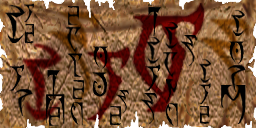 |
| The thrice sealed house withstands the storm |
Overall Analysis
Tengwar
is an incredibly well-built language, and is used extensively in Tolkien’s
books to add depth to his worldbuilding. As a script, it functions much like
Tibetan and other Brahmi-derived languages, with diacritical vowels and small
modifiers to change between consonants. Tengwar’s primary strength is in its
system of creating numerous phonetic combinations with only a small set of base
shapes, and its main weakness is in the number of rules that a writer must keep
track of to accurately say the right thing. The dual modes present an added
layer of complexity which is great for mythos, but a nightmare for a practical
application of the script. All in all, Tengwar is a complex language based on a
large number of simple principles.
Circular Gallifreyan is born
from the Time Lords’ understanding of the cyclical nature of time. Its script
consists entirely of circles and lines, and sentences are circles within
circles. For anyone writing the script, many aesthetic decisions are entirely
up to the author’s discretion; for anyone reading the script, it is hard to
understand without first undoing much of the work that went into structuring
the sentence. Circular Gallifreyan is simultaneously simplistic in its
character system and complex in its sentence structure. The varying levels of
detail make the script easily legible in short form yet exceedingly arcane in
long form.
Daedric
script was created to be a direct one-to-one transcription to and from English,
and so lacks many of the features that make the other two languages so
unique. What Daedric does offer, however, is a look into how we view the
letters themselves, and how the general ‘feel’ of a script can give meaning and
mythos to a story. The rough characters crop up periodically in the Elder Scrolls video games, and whenever
they do, it means the occult is soon to follow. As a script,
Daedric provides a way to write English in a completely new way without the
need to learn new structural rules, only a character set.
Recommendations for Writers
It is
hard to say what makes a ‘good’ language and what makes a ‘bad’ one. We can,
however, observe what features some popular fictional languages employ and see
what impact they have on the script and how readers understand it. Diacritics
can be a great tool for cleaning up a language, such as making vowels purely
diacritical, but if you only want to make a written language, then leaving them
out is perfectly fine. As long as you have well-defined rules for their usage,
anything goes for what marks you put on your characters. Multiple characters
that share a common base form can give you a lot of flexibility and let a small
number of shapes cover a wide range of letters. On the other hand, perhaps you
want to make a script that has many distinct shapes, in which case you can come
up with your own glyphs or modify letters from real world scripts to suit your
needs. In any event, however, your language must be able to convey its meaning
to the reader. If no one can understand what your script says, then what useful
purpose does it serve? Employ as many or as few of these devices as you wish,
just remember that ‘more complex’ does not necessarily mean ‘sophisticated’,
and ‘simple’ doesn’t mean ‘crude’. As long as your language can make its
meaning clear through whatever features you decide to use, then any language
can be a great one.
References
“A Guide to the Gallifreyan Alphabet.” Sherman, Loren. n.p., n.d. Web. 2 April2014.
"Biangbiang noodles." Wikipedia. MediaWiki, 1 March 2014. Web. 2 April 2014.
"Biangbiang noodles." Wikipedia. MediaWiki, 1 March 2014. Web. 2 April 2014.
“CircularGallifreyan.” Timeturners. Wikidot,n.d. Web. 2 April 2014.
"Daedric Alphabet." Ager, Simon. Omniglot. Kualo, 2014. Web. 2 April 2014.
"Daedric Alphabet." Ager, Simon. Omniglot. Kualo, 2014. Web. 2 April 2014.
